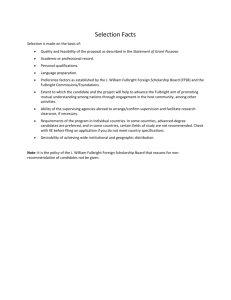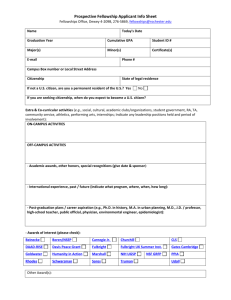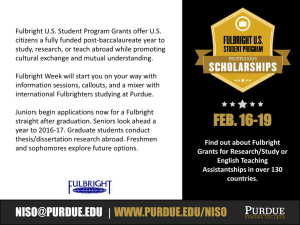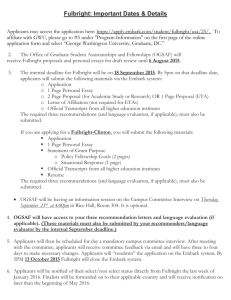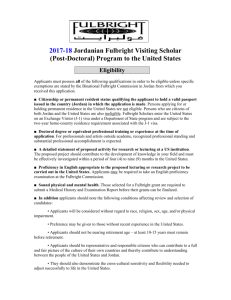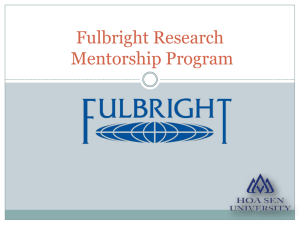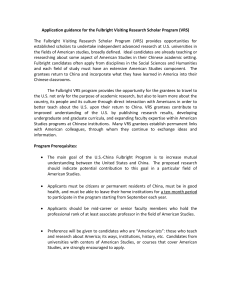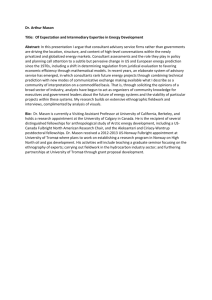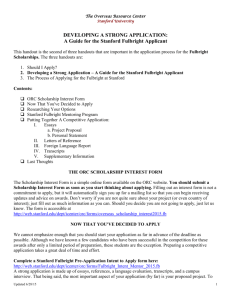The Fulbright Essays
advertisement
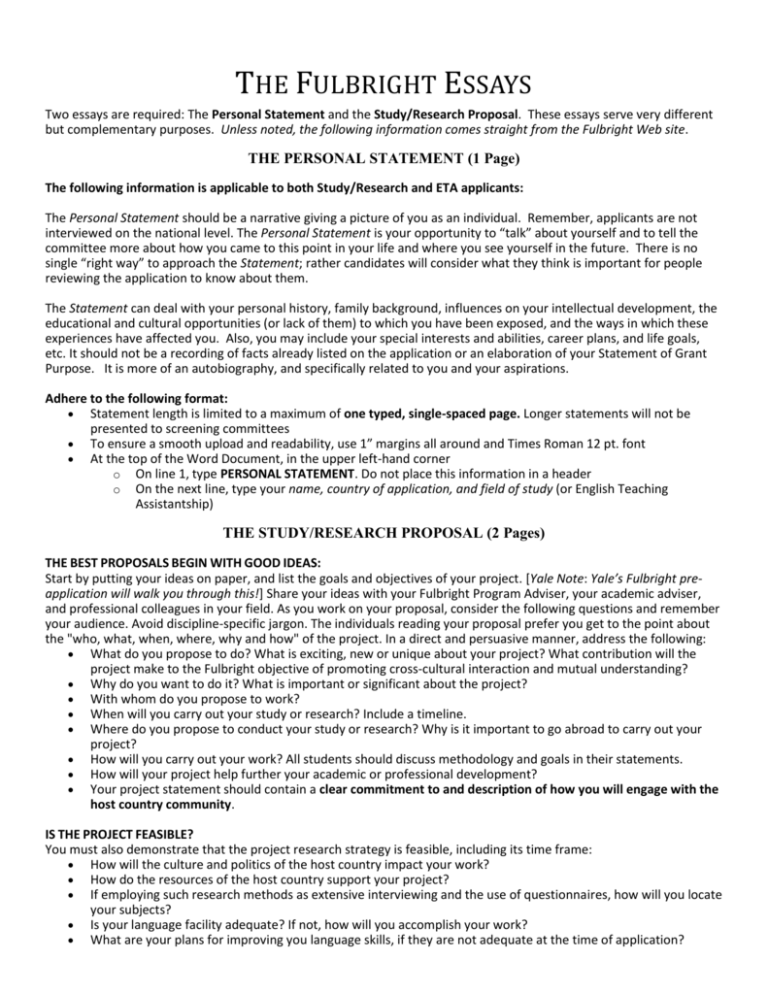
THE FULBRIGHT ESSAYS Two essays are required: The Personal Statement and the Study/Research Proposal. These essays serve very different but complementary purposes. Unless noted, the following information comes straight from the Fulbright Web site. THE PERSONAL STATEMENT (1 Page) The following information is applicable to both Study/Research and ETA applicants: The Personal Statement should be a narrative giving a picture of you as an individual. Remember, applicants are not interviewed on the national level. The Personal Statement is your opportunity to “talk” about yourself and to tell the committee more about how you came to this point in your life and where you see yourself in the future. There is no single “right way” to approach the Statement; rather candidates will consider what they think is important for people reviewing the application to know about them. The Statement can deal with your personal history, family background, influences on your intellectual development, the educational and cultural opportunities (or lack of them) to which you have been exposed, and the ways in which these experiences have affected you. Also, you may include your special interests and abilities, career plans, and life goals, etc. It should not be a recording of facts already listed on the application or an elaboration of your Statement of Grant Purpose. It is more of an autobiography, and specifically related to you and your aspirations. Adhere to the following format: Statement length is limited to a maximum of one typed, single-spaced page. Longer statements will not be presented to screening committees To ensure a smooth upload and readability, use 1” margins all around and Times Roman 12 pt. font At the top of the Word Document, in the upper left-hand corner o On line 1, type PERSONAL STATEMENT. Do not place this information in a header o On the next line, type your name, country of application, and field of study (or English Teaching Assistantship) THE STUDY/RESEARCH PROPOSAL (2 Pages) THE BEST PROPOSALS BEGIN WITH GOOD IDEAS: Start by putting your ideas on paper, and list the goals and objectives of your project. [Yale Note: Yale’s Fulbright preapplication will walk you through this!] Share your ideas with your Fulbright Program Adviser, your academic adviser, and professional colleagues in your field. As you work on your proposal, consider the following questions and remember your audience. Avoid discipline-specific jargon. The individuals reading your proposal prefer you get to the point about the "who, what, when, where, why and how" of the project. In a direct and persuasive manner, address the following: What do you propose to do? What is exciting, new or unique about your project? What contribution will the project make to the Fulbright objective of promoting cross-cultural interaction and mutual understanding? Why do you want to do it? What is important or significant about the project? With whom do you propose to work? When will you carry out your study or research? Include a timeline. Where do you propose to conduct your study or research? Why is it important to go abroad to carry out your project? How will you carry out your work? All students should discuss methodology and goals in their statements. How will your project help further your academic or professional development? Your project statement should contain a clear commitment to and description of how you will engage with the host country community. IS THE PROJECT FEASIBLE? You must also demonstrate that the project research strategy is feasible, including its time frame: How will the culture and politics of the host country impact your work? How do the resources of the host country support your project? If employing such research methods as extensive interviewing and the use of questionnaires, how will you locate your subjects? Is your language facility adequate? If not, how will you accomplish your work? What are your plans for improving you language skills, if they are not adequate at the time of application? If there could be any question regarding the feasibility of your project or your background or ability to conduct the project, address the issue directly in your statement. Enrolled students are urged to consult professors in their major fields and their FPAs about the feasibility of their proposed projects. At-Large applicants should consult qualified persons in their fields. Please note: Applicants should determine if the host country has specific visa or research clearance requirements. This will be noted in the Country Summary. If required visas and/ or research clearance(s) are denied by the candidate’s host country, reassignment to a new country is normally not an option. Don't make reviewers search for information. We urge you to have several people read and critique your Statement, including a faculty adviser, a faculty member outside your discipline, a fellow student, and/or a colleague. Adhere to the following format: Statement length is limited to a maximum of two typed, single-spaced pages. Longer statements will not be presented to screening committees. Do not include any bibliographies, publications, citations, etc., except those that will fit in the two-page limit. To ensure a smooth upload and readability, use 1” margins all around and Times Roman 12 pt. font. At the top of each page of your Word document type the following: o On line 1, type STATEMENT OF GRANT PURPOSE o On line 2, Place your Name, Country of Application, and Field of Study o On line 3, type Project Title as it appears on Page 3 (Form 2) of the application (on the first page of the Statement only) TEACHING ASSISTANTSHIPS STATEMENT of GRANT PURPOSE (1 Page) Since you are applying for an ETA, you are not expected to present extensive research plans. The following are guidelines as to what you could include in your Statement: Why would you like to undertake a Teaching Assistant assignment? Why have you chosen the particular country? What specific qualifications, training, and/or experiences do you have related to the overseas assignment? What use will you make of your time outside the classroom (Most ETAs work no more than 20-30 hours/week? How you expect to benefit from the assignment, and what use you will make of the experience upon your return to the United States? [Yale Note:] What do you hope to learn from the assignment? Keep in mind that the maximum length for the Statement of Grant Purpose and Personal Statement is one-page each. Therefore, you should construct these Statements in such a way as to include all pertinent information, but so as not to be redundant. Most ETA programs expect that grantees will engage in an independent academic, vocational, or community service project. You should briefly describe what you would like to do in the Statement of Grant Purpose. Since applicants will not know exactly where they will be located, this description is not expected to be detailed. You simply need to indicate the activities that you intend to pursue outside of the ETA responsibilities and why you have chosen this/these activities for the country to which you are applying. In addition, any community service activities or extra-curricular activities that you think you might conduct should be described. If you have a very specific proposal for study or research, you may wish to consider the Study/Research option, since in the ETA program you will not be able to choose where you will be placed and you will not have very much time for independent research or study. Furthermore, successful ETA's are those who value the experience of working in an educational environment first and foremost. We have seen highly qualified applicants not selected because the impression from their Statements indicated that they were more focused on a project than on the ETA assignment. Adhere to the following format: For English Teaching Assistantships, the Statement length is limited to a maximum of one typed, single-spaced page. Longer statements will not be presented to screening committees. To ensure a smooth upload and readability, use 1” margins all around and Times Roman 12 pt. font. At the top the page of your Word document type the following. Do not place this information in a header, it will not upload. o On line 1, type STATEMENT OF GRANT PURPOSE o On line 2, type your Name, Country of Application, and English Teaching Assistantship [Yale Note:] ADDRESSING ENGAGEMENT IN THE COMMUNITY Since the primary aim of the Fulbright Program is to further mutual understanding between the people of the United States and other countries, it is important to address this issue in your application. Your application should demonstrate a clear commitment to the host country community. Being involved in the local community will contribute significantly to the Fulbright Program's goals and will enhance your experience in many ways. IIE advises that applicants should describe any volunteer or extracurricular activities of interest to them and relate the activity to the Fulbright grant experience. You can choose to address this in your Project Statement, if the planned activity is an integral part of your study or research, or in the Personal Statement, if the planned activity is more extracurricular. If you will be in a university environment, this activity could be extracurricular (joining a club, participating in a sport, etc.); it does NOT have to relate specifically to your study proposal. Other examples of community involvement could include teaching or tutoring English or American Studies; volunteering with a charitable organization, volunteering for a school renovation project, volunteering in a healthcare facility, etc. [Yale Note:] ALSO SEE: "Writing Fellowship Essays": http://www.yale.edu/yalecollege/academics/fellowships/application/essays.html U.S. Student Fulbright Applicant Blog: http://blogs.fulbrightonline.org/usapp/ Podcasts: http://blogs.fulbrightonline.org/usapp/new-podcasts-available-on-httpus-fulbrightonline-org NOTE: Resist the temptation to look at the samples below BEFORE you have completed Yale’s Fulbright pre-application and have begun to sketch out your own reasons for applying. While the samples linked below are useful for demonstrating well-structured essays, it is the quality of the content (the clarity of your convictions and your own purposes for applying) that set the foundation for strong essays. Samples from others cannot do that work for you! Samples of Winning Essays On-line: Penn State University: https://www.e-education.psu.edu/writingpersonalstatementsonline/p5_p4.html Temple University: http://www.temple.edu/studyabroad/students/fulbright/sample_essays.htm University of Iowa: http://international.uiowa.edu/funding/fulbright-resources University of Rochester: http://www.rochester.edu/college/CCAS/fellowships/fulbright/samples.html FELLOWSHIP PROGRAMS YALE COLLEGE CENTER FOR INTERNATIONAL & PROFESSIONAL EXPERIENCE www.yale.edu/fellowships (Revised April 2012) PERSONAL NOTES:
